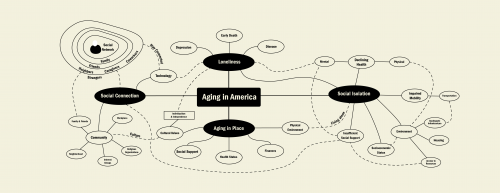Project Name: Interspace
Topic/Problem:
A survey by AARP found that around 42.6 million adults over age 45 consider themselves to be consistently lonely (Singer, MD, Spring 2018). Becoming lonely is a problem that spans age groups, cultures, and economic classes. A contributing factor to loneliness is social isolation. According to a literature review, a lack of social connectedness is considered as dangerous as being overweight, not exercising, or smoking a dozen cigarettes a day. Holt-Lunstad, a psychologist at Brigham Young University, collected data from over 140 studies and 300,000 participants through the American Psychological Association. She found that increased social connection was linked to a 50% reduction in the risk of early death. Another collection of 70 studies and over 3.4 million participants found a correlation between social isolation, loneliness, or living alone affected the risk of premature death (Holt-Lunstad, 2017).
Being socially connected is a basic biological and psychological need for humans that is easier to prevent than to treat after the fact (Hold-Lunstad, September 2017). Belonging and feeling close to others allows us to be emotionally, mentally, and physically healthy and therefore allows us to have a culture, countries, cities, communities, and homes that are also psychological, physical, and emotionally healthy.
Primary research showed that Public spaces such as parks and community centers can provide small social interactions for seniors, but a lack of facilities, poorly designed environments and unpredictable quality {what kind of poor design would be helpful to understand] of the public transport service can make these places more of a hassle than enjoyable which can “reduce participation in society and further diminish older people’s capacity for autonomy and independence to enjoy the public realm” (Clark, et al., 2019; p. 25).
User-testing showed that although people craved interaction and acknowledgment, a prolonged conversation between strangers was deemed uncomfortable. A well-designed environment can facilitate interaction, and places such as community gardens, libraries, public parks, and civic plazas provide space to connect with others and meet new people. (Clark, et al., 2019; p. 63).
At a bus stop even if it’s not a deep conversation, a mere hello to a stranger, it is still an interaction that influences that person, the next person they meet, and the next person. Ever noticed how a friendly bus driver can change the demeanor of a whole bus? Friendliness is contagious (Goodyear, 2010).
With these findings, How might we tackle social isolation and the all-too-human emotion of loneliness that can emerge among elderly Americans living on their own and how might we encourage social connection among strangers in public spaces?
Solution:
Public transportation is a key part of providing social connectedness for many groups including aging Americans. Bus stops provide a unique meeting point for people of all demographics to share micro-interactions.
Interspace is a traveling social pop-up experience and ethnographic documentation of behavior. The goal of the project is to show the commonalities across bus travelers in the western world and encourage positive feelings and micro-interactions between travelers.
An interactive bench uses color and light to encourage positive feelings. The bench lights up when a person sits down on it and the light grows brighter each time a new person sits down to encourage people to look up and recognize those around them.
The project would pop up in various bus stops locations across the western world with interactions and behavior documented through photos and videos. This documentation would ultimately find a home in a museum featuring the photos and the final bench to emphasize the commonalities across cities.
Ultimately the project’s goal is to remind us that we are not that different from one another and we are all in this together.



Sources:
Clark, G., Amabile, M., & Postone, Z. (2019). Cities Alive: Designing for Ageing Communities. 103–113.
Goodyear, S. (2010). An experiment in encouraging in-transit conversation. Grist Magazine. Retrieved from https://grist.org/article/2010-12-22-an-experiment-in-encouraging-in-transit-conversation
Holt-Lunstad, J. (2017, August 5). So Lonely I Could Die. Retrieved September 2019,
from https://www.apa.org/news/press/releases/2017/08/lonely-die.
Singer, MD, C. (n.d.). Health Effects of Social Isolation and Loneliness. Journal of Aging
Life Care. Retrieved from https://www.aginglifecarejournal.org/health-effects-of-social-isolation-and-loneliness/

